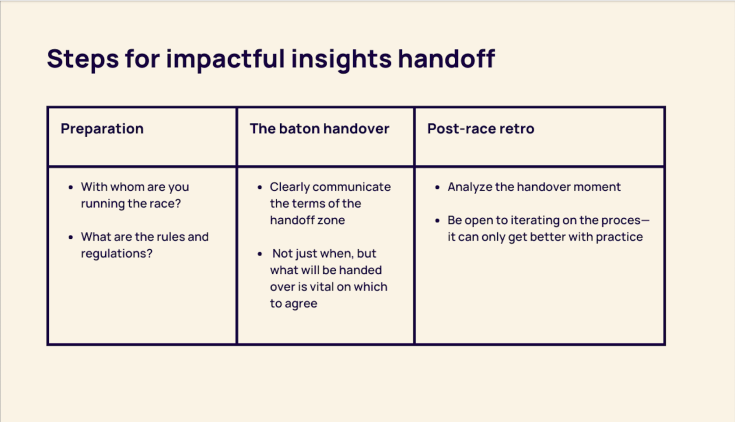The Baton Handover: making insights actionable

“We need to make our insights actionable.” As user researchers, we hear this message constantly. It doesn’t matter if we’re fascinated by the results of a research project we crafted and conducted. We must ensure that somebody uses those insights. For example, our findings lead to a particular design decision. Or they assist a product team in scoping a new feature. Or they help us realize where we need research, so we can understand the problem before approaching a solution.
“Actionable insights” mean that your research findings can improve users’ experience in some way. There are many different ways to create and articulate them. The question remains—how do we make insights actionable? Is there a magical formula that ensures stakeholders know what to do with the insights we produce?
It’s not magic. But done correctly, it almost looks like it. The how, my fellow researchers, can best be understood in the context of a maneuver you might be familiar with from relay races: the baton handover.
The research project as a relay race
I love watching relay races. It’s easy to admire the speed and grace of the athletes. But the moment I hold my breath is when the runner hands the baton to the next race participant. That handover happens in a flash and can make or break a team’s chance for success. The more they have prepared and communicated their handover strategy, the more likely they will succeed.
When we view our research project as a relay race, the moment we hand our insights off to our stakeholders is synonymous with a baton handover. But success consists of more than just the handover. A successful race requires meticulous preparation leading up to that moment. It also needs a post-race retro, so the team improves its execution and learns from past mistakes. Let’s take some time to talk about each of these elements.
Preparation
A research project is like a relay race because it’s not just up to the researcher to run the distance to complete the race. It requires an insights handoff. In other words, it needs other participants to make it happen. Preparation is vital, and there are a few important questions to ask as you complete this step:
With whom are you running the race?
Figure out who your key stakeholders are before the research project kicks off. “With whom” goes beyond simply identifying who your stakeholders are. You need to identify their expectations and assess whether they’re reasonable. It requires you to know if they have a deadline for receiving the insights. You need clear communication around the handover—will you share broad themes? How Might We statements? Insight “nuggets”? Do stakeholders want you to move into the solution space after sharing your insights, and are you comfortable doing so?
What are the rules and regulations of the race?
Relay races require participants to follow strict procedures or face disqualification. Similarly, research project stakeholders need to know what is expected of them. More broadly, their role—and your role—should be communicated clearly before the project starts. For example, what role will your non-research stakeholders play regarding interaction with your research participants? If they participate in the interview process will they ask questions or observe? Are their observations taken into account when analyzing the data? What process do you follow if you disagree on the conclusions?
You’ve done it—you’ve answered these questions. You’ve prepared, and it’s here—the race is on! It’s almost time to hand over the baton.
The baton handover
The baton handover is all about precision. In a relay race, the receiver waits until she sees the passer enter the handoff zone and begins jogging forward to receive the baton, allowing her to continue the race already in motion.
The handoff zone is marked and strictly regulated, and a handoff that occurs outside the demarcated area results in disqualification. Similarly, you must be aware of any consequences for failing to hand off research insights at a given moment. Say our stakeholder has a strict deadline and must proceed with development or design by a specific date. Or there’s an important leadership meeting in a month. Before that meeting, we need to plan an insights debrief so our stakeholder can approach leadership with fresh knowledge from our project.
In a relay race, the handover occurs at a split-second moment. In an ideal situation, this happens as quickly and smoothly as possible. The aim is to get the second runner on her way with the baton firmly in hand. Our stakeholders would agree: knowing when and how they will receive our insights and what they can do with them will make all the difference to the success of our research project.

Post-race retro
Take it back to the heart of the operation: our work within an organization should serve the overall aim to deliver delightful products or services to our users. If we perform a successful handoff to our stakeholders, they can do something actionable with our insights.
So: what happened? How did it go?
We’re all familiar with the retro, but I’d encourage you to think explicitly about the handover moment when conducting a retro for your next research project. That means asking your stakeholders how they’ve incorporated your insights into their work. This could be a tough conversation, especially if they’re unsure or critical. But opening up this direct line of communication and iterating on our process is an excellent way to improve.
It can be motivating to think about how athletes precisely set themselves up to run a successful relay race and what we can learn from them when planning for success in our user research projects.
I started this article with a brief description of different kinds of actionable insights from both evaluative and generative research. There’s an additional benefit from ensuring our baton handover is smooth and well-communicated: Our research project, with its insights handover strategy iterated time and again, could lead to impactful changes within a team’s or even an entire organization’s mindset.
Now, get out there and run that race!
Written by Janelle Ward, Principal Consultant, Janelle Ward Insights. Janelle has led UX research at digital product companies, both as a founding lead and as a manager upskilling and growing existing research teams. Janelle has a background in psychology and digital communication and spent a decade as an assistant professor before transitioning to UX research. She writes regularly about career and research topics. Outside of work, her life is a mix of parenting, partnering, reading great fiction (and trying to write it), caring for horses (not hers), and a dog and two cats (hers).
Get started for free
Log in or sign up
Get started for free
or
By clicking “Continue with Google / Email” you agree to our User Terms of Service and Privacy Policy


